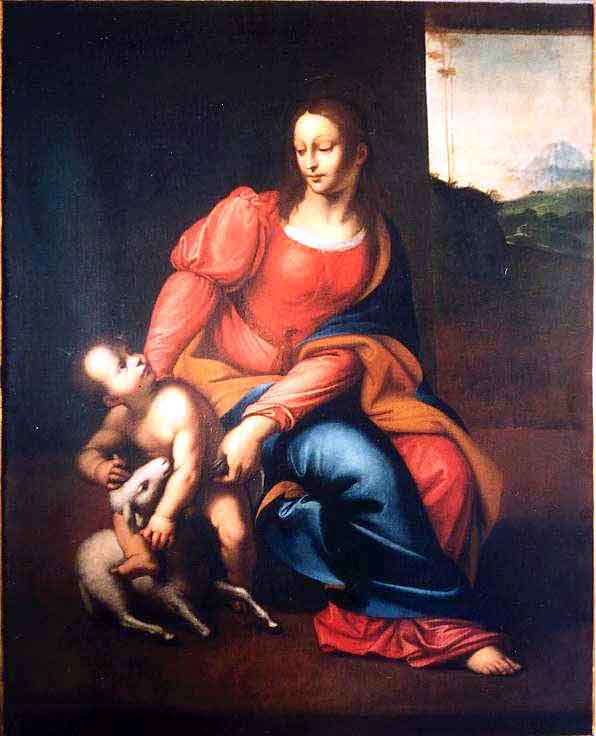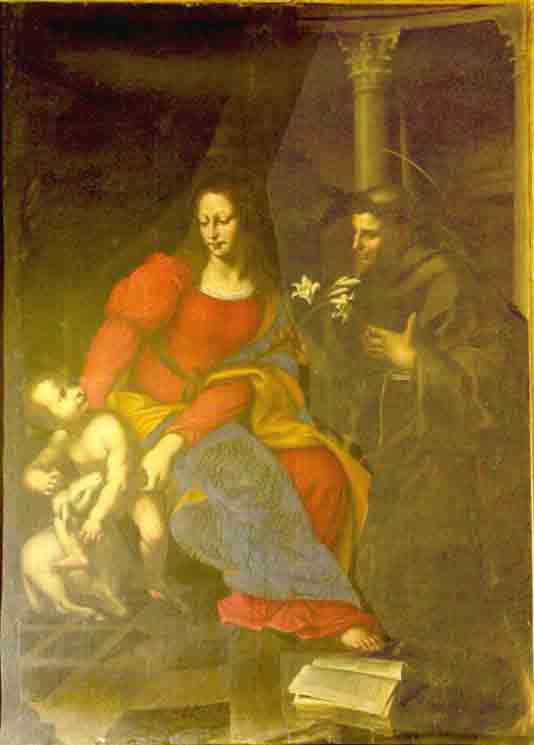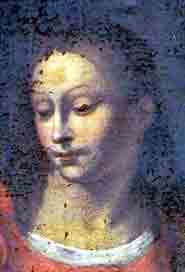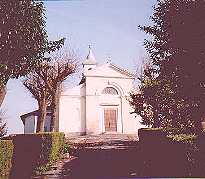LA TESI DELLA PATERNITA' LEONARDESCA
FORMULATA DAI PROF.RI MARIO MASCETTI ED ERNESTO SOLARI
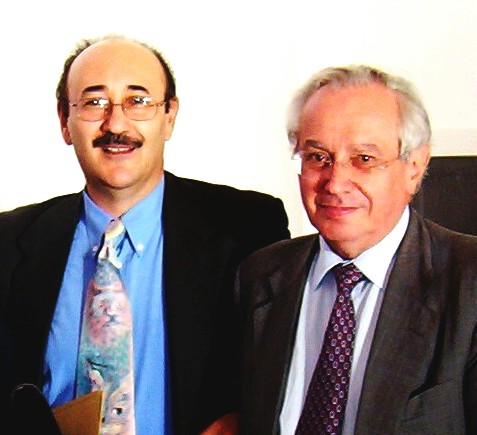
The Holy Family of Lipomo
Among
the prints of the collection Civica Bertarelli of Milan there is an apocryphal xylography
datable between the end of 1400s and the beginning of 1500s, which represents the Last
Supper and a Holy Family signed by Leonardo da Vinci (Leonardus fecit).
Of this work attributed to Leonardo there is no longer trace.
The
thesis which is here being put forward is that the Holy Family in the xylography is
identifiable with the painting (already considered of Leonardo’s school) kept in the
church of Lipomo (Como).
Indeed the painting recalls the Saint Anna of the Louvre, in that it reproduces the
Child riding the Lamb. Furthermore the representation of the Madonna is very similar to
that of the Louvre, however the upright posture brings it closer to the Saint Anna.
It is undeniable that there is a strong link between the two paintings. Othen than
the above mentioned xylography, this is proved by the existence of numerous copies
produced by the pupils closer to the Maestro such as that of Marco D’Oggiono, in the
Archinti collection in Milan; that of the Giampietrino in Ospedaletto Lodigiano; that of
the Salaino kept in the Museum of Science and Technology of Milan and lastly, the
(recently found) copy attributable to Melzi and currently in a private collection in
Milan. All these copies faithfully reproduce the scheme of the composition: the Madonna
with the Child who plays with the Lamb; however in all of them Saint Joseph is ignored.
Nonetheless He is present in the painting of Lipomo, as also suggested in the xylography
of the Collection Bertarelli.
The extraordinary connection with the Saint Anna and the omission of Saint Joseph
in numerous copies, has urged to seek an explanation, for the dating and the subsequent
placement of the work in the artistic path of Leonardo.
It is stimulating to verify whether there are the conditions to attribute the work
to Leonardo, or at least the acknowledgment of a partial paternity.
Therefore we have investigated many of Leonardo’s manuscripts and drawings in
order to find evidence and possible connections with the painting.
We found particularly illuminating the observation and analysis of the elements contained in the Windsor drawing RL 12283 that Pedretti suggests to date back to 1498 but that could actually be a few years younger.
“We can think – writes Pedretti about the content of the drawing – that the geometric figures have been placed in that order and linked with all the other elements to generate a sense of unity in the composition. It seems indeed that Leonardo had considered them in relation to the figurative elements to obtain a rhythmic equilibrium in the page”. However the concept that Pedretti applies to the RL 12283 would seem more applicable to the Lipomo painting.
A rather surprising coincidence is the fact that on the same side of the Windsor drawing appears another lancet-arched pyramid which seems to contain the Saint Anna of the Louvre with a different diffusion of light. It is evident how the base, unlike the first painting, is not aligned on a straight line but it looks like a curve which encircles the edges of the figures so that the perspective maximises the relief-model, tridimensional effect.
The old man near the tree of the RL 12283, seems to be a study for the Saint
Joseph, imagined in the first place as external observer of the scene, later portrayed in
the external space outside the window/door in the Holy Family of Lipomo. It is
interesting to notice the resemblance of the hair even if the physiognomy of Saint Joseph
is that of a younger man. Is it only suggestion to think of that as the portrait of
artist’s father, Ser Piero?
The clam is based on the fact that in many occasions Leonardo himself associates
the father with the image of the tree in his writings.
In the RL 12283 we can notice two soldiers (preparations for successive studies for
The Battle of Anghiari) whose attitude seems to allude to the theme of justice. On
the side is a lily and the structure of a “lilied M” which refers to Dante
(Paradiso, Canto XVIII): it is the theme of justice brought about in the ‘Allegory of
Navigation’. The characters cited by
Dante become subjetcs of many of Leonardo’s paintings: San Gerolamo, the
Annunciation, San Giovanni Battista, S.Anna, the Leda (cited by Dante as constellation).
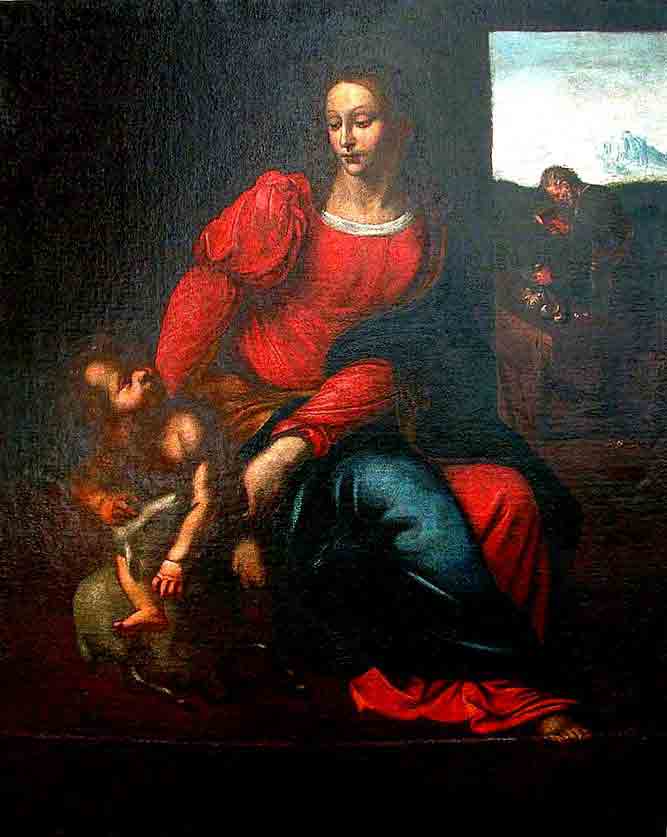
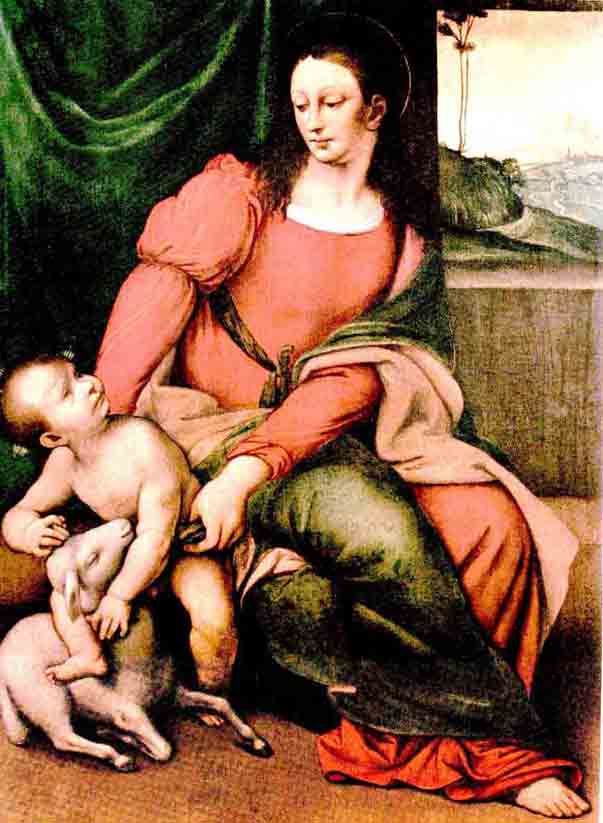
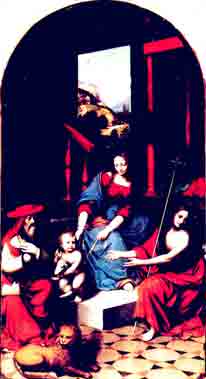

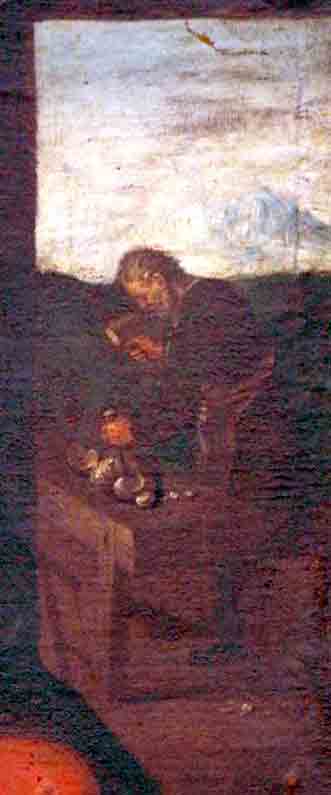
The chromatic quality
The scheme of the composition and the structure of the painting lead to assign the paternity to Leonardo. Doubts about this could be risen about the chromatic quality of the painting, which is not comparable to the level of Leonardo’s masterpieces.
There are nevertheless some details in the painting that, in our view, confirm Leonardo’s intervention as their chromatic quality is similar to that of his main works.
We cite for instance the Child’s face, approachable to the carton of Saint
Anna and the left arm with chromatic effects similar to those of the Child in the Virgin
of the Rocks at the Louvre.
Various details in the paint drapery and in the Madonna’s garment are comparable to those of other Madonne (Benois, Announciation, Madonna with the Carnation, ecc).
The mountain landscape contains chromatic and light effects responding to the
criteria illustrated by Leonardo in his Treaty on Painting.
The X-ray exam
On January 10th 2002, the Ditta Gilardoni of Mandello carried out the
x-ray exam of the Lipomo painting. The results are the following:
1. There
has been no background preparation: the painting has been produced straight off on canvas,
that is why in various points the colour has come off and the canvas is visible.
2. Some
details have been re-painted (bits of Mary’s foot and hand, the left-middle part of
the mountain landscape).

Ecco il
particolare del volto
Historical hints
The painting is for the first time cited in Lipomo in 1873, where it probably arrived in 1868. It must have arrived after the works for the enlargement of the church, which also included the renovation of the altars.
The clues lead us to think that the painting came from the former church of Saint Antonio in Como, where it arrived after 1578 most likely from the picture gallery of Paolo Giovio (the famous historian). How do we get to this conclusion?
In 1578 the bishop of Vercelli, mons. Francesco Bonomi visited the diocese of Como, saw the church of S. Antonio and ordered the substitution of the ancon of the altar, because too old. In that period, responsible for the church was mons. Paolo Giovio junior, bishop of Nocera, who had just replaced monsignor Giulio Giovio. This one had inherited the picture gallery of uncle Paolo Giovio senior, the historian, who had also been responsible for the same church. Strangely, instead of ordering a brand new altarpiece with the image of S. Antonio, mons. Paolo Giovio must have decided for this Holy Family. This is proved by the fact that still in 1700 the main chapel was not dedicated to S.Antonio but to the ‘Sacra Famiglia’ even if the painting (after the renovation and the replacement of the altar with a new baroque one) was moved to the chapel on the right, where the Bonanomis had their family tomb.
After 1790 the church began to be profaned, with the dispersal of the artistic treasures. Around 1860 were all the properties of the church alienated. The papers for the alienation of the properties and possessions of the former convent of S.Antonio were in the hands of the notary Tomaso Perti, who was Prime Deputy of Lipomo during the Austrian occupation. Second deputy was Antonio Bonanomi from the same Bonanomi family, whose tomb was located in the right chapel of the church. The Holy Family was kept in the same chapel, dedicated to Saint Joseph. The painting was used as altar-piece, framed in stucco, as stated in an inventory of 1772, kept at the State Archive of Milan. The fact that the painting never had a wooden frame can lead us to think identify the Holy Family of Lipomo with the one of S. Antonio.
There were also other reasons for which the painting may have arrived Lipomo. The convent of S. Antonio is documented as proprietor of estates in Lipomo since the XVIII century. The same Paolo Giovio who owned the picture gallery, had collected rents for some properties in the area. Probably in his gallery the Holy Family was the only sacred object which could be exposed as altarpiece.
